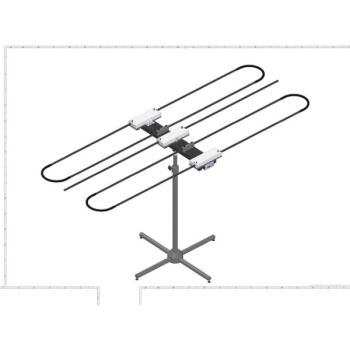
SteppIR Communication Systems
The New Standard for MIL-STD-461G
30-200MHz
Prior to the introduction of MIL-STD-461F it was possible to perform RF susceptibility tests using currently available antennas on 30-200MHz. MIL-STD-461F was introduced to address the deficiencies of previous RF
susceptibility standards and thus made it extremely difficult and expensive to achieve successful testing using existing antenna technologies. Because the SY3-EMC Yagi is a High-Q, adjustable antenna that has very high efficiency, a wide beam-width, and excellent harmonic rejection, it makes susceptibility testing to the specifications of now MIL-STD-461G and RS-103, a reality.
SY3-EMC PRINCIPLE OF OPERATION
The SY3-EMC is a tunable antenna system that allows precise control of all the element lengths. This allows very broad frequency coverage with a single antenna while maintaining ideal performance characteristics. This technology is especially useful in the case of Yagi antennas because they are essentially single-frequency devices. The ability to automatically adjust the antenna also allows operation in less-than-ideal locations such as EMI chambers where room effects seriously detune antennas in the 30MHz to 100 MHz range. The basic antenna element consists of two reels of the perforated copper-beryllium strip that are driven by a microprocessor-controlled stepper motor, which allows very precise control of the copper-beryllium element. Power is delivered to each of the copper-beryllium conductors via a specially designed mechanical brush that is rated for 2.5 KW with a 100% duty cycle. The SY3-EMC Yagi incorporates a patented fold-back technique that reduces the size of the antenna by 40% while decreasing gain by only 0.3 dB. This unique element design also keeps the high voltages at the tips away from structural surfaces, thus minimizing E-Field pattern distortion and maintaining a very high return loss.
Auto-Tuned, Turnkey System – Introducing the OptimizIR-EMC
The OptimizIR-EMC auto-tune System is a patent-pending software algorithm that interacts with our proprietary EMC Analytic Tower (EAT), which is located outside of the test room. The OptimizIR-EMC monitors feedback from the analytic tower and then creates an optimized, resonant antenna – at every single test frequency within its range, in both the horizontal and vertical positions. The tuning process is completely automated, there is no need for a technician to be present during tuning.



